Amplemarket Alternatives
Find your Amplemarket alternative. This guide compares 10 sales platforms with a breakdown of features and pricing to help you choose.

Many sales teams choose Amplemarket for its sales engagement tools. The platform performs well for automating outreach and generating leads. It helps users scale personalized campaigns, which makes it a solid option for many companies.
But, like any tool, it has limits. Some users note a learning curve, missing features, or occasional data issues. We analyzed the top alternatives based on G2 reviews to help you find the best fit for your team. Let's get started.
A Note on Digital Workers: Consider 11x
For teams exploring digital workers, 11x presents a different option. The platform provides autonomous agents to handle sales development tasks like prospecting and outreach. This can be a practical way to support your sales function without adding headcount.
11x is a GTM platform with AI agents that manage the sales process. Alice finds prospects, handles outreach, and updates the CRM. Julian qualifies inbound leads and books meetings. It combines data enrichment, outreach, and email warmup, which can replace separate point solutions.
Amplemarket Alternatives
We will now cover the top Amplemarket alternatives in detail. Each review examines pricing, core features, and the main advantages and disadvantages compared to Amplemarket.
1) Outreach
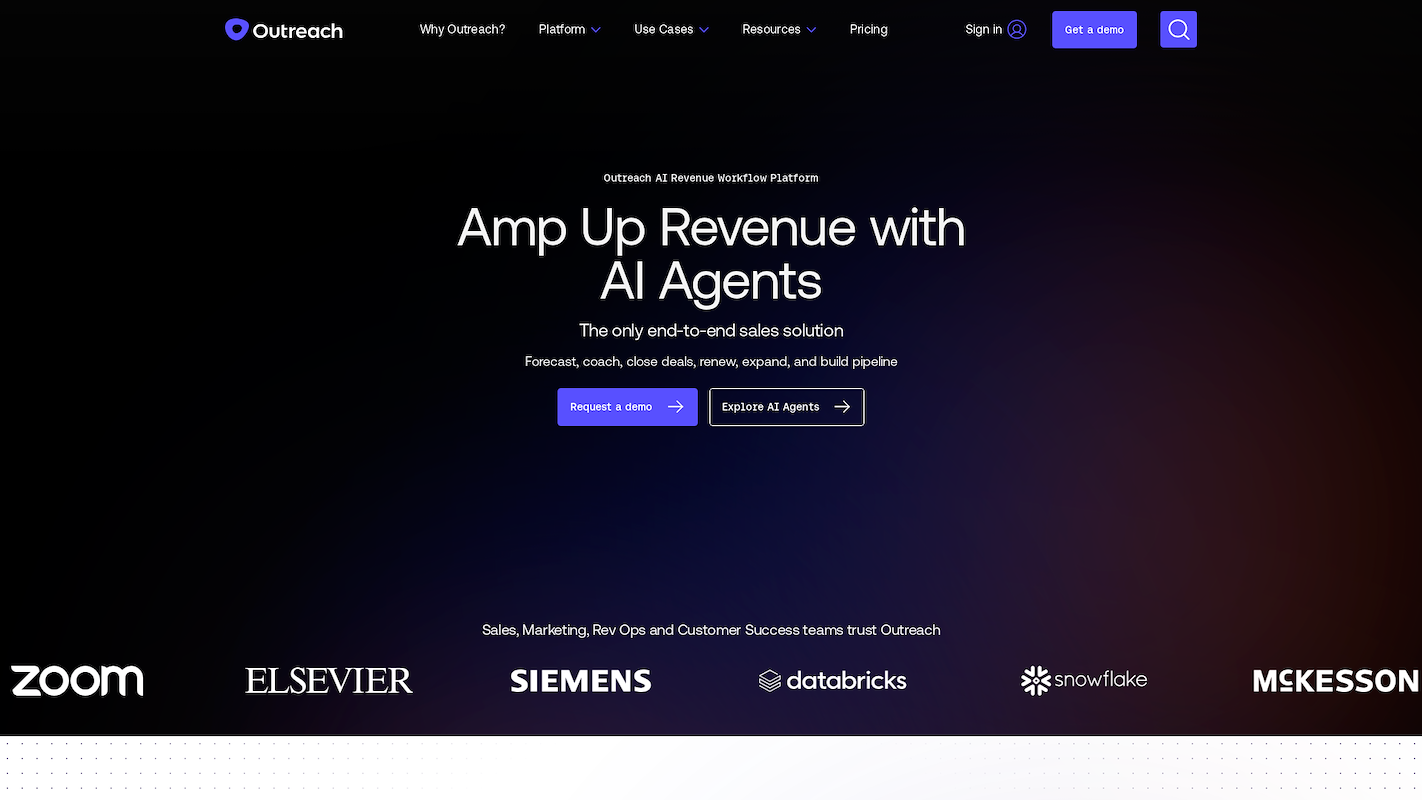
Outreach is an AI-powered platform for revenue teams. It offers an end-to-end solution for sales execution that combines AI agents, data workflows, and forecasting. The system emphasizes security and governance for customer data.
Use cases include the organization of business books, outbound communication, and deal management with AI insights. The platform also supports revenue forecasts and scales coaching programs through automated meeting analysis.
Outreach's Main Features
- Offers AI-driven rep coaching through Kaia, providing meeting summaries and analytics with deep-linked call moments for managers.
- Predicts revenue outcomes, identifies pipeline gaps, and runs scenario forecasts using its analytics tools.
- Detects topic and buyer sentiment across meetings, calls, and emails to provide a comprehensive view of interactions.
- Delivers real-time content guidance and enablement content cards during live meetings via its AI assistant.
How Outreach Compares to Amplemarket
Average Review score: 4.3/5 stars based on 3,479 G2 reviews
- Outreach offers AI-powered sales coaching that analyzes meetings to provide feedback. This feature is more developed compared to the core coaching functions in Amplemarket.
- It includes revenue forecasting tools to predict sales outcomes and find pipeline gaps. This provides a different level of financial insight than Amplemarket's focus on outreach.
- The tool analyzes buyer sentiment across communications like calls and emails. This offers deeper interaction analysis than the standard engagement tracking in Amplemarket.
- This platform unifies sales engagement with revenue intelligence and operations. This is a broader scope than Amplemarket, which concentrates on sales engagement and lead generation.
Where Outreach Differs From Amplemarket
- Some users report sequence problems, which can disrupt campaigns. Amplemarket, in comparison, builds its platform around a strong sequencing tool for large-scale outreach.
- The tool sometimes has data sync issues with CRMs, based on user feedback. Amplemarket's focus on lead generation means its system depends on stable data handling.
- Its broad set of features can sometimes slow the platform down. A more focused tool like Amplemarket may feel faster for users who only need outreach functions.
Pricing, Plans, and Value
Outreach does not publish its pricing, but user reviews indicate a high perceived cost, similar to Amplemarket. Both platforms typically require contacting their sales teams for a custom quote based on your team's specific needs.
2) Salesloft
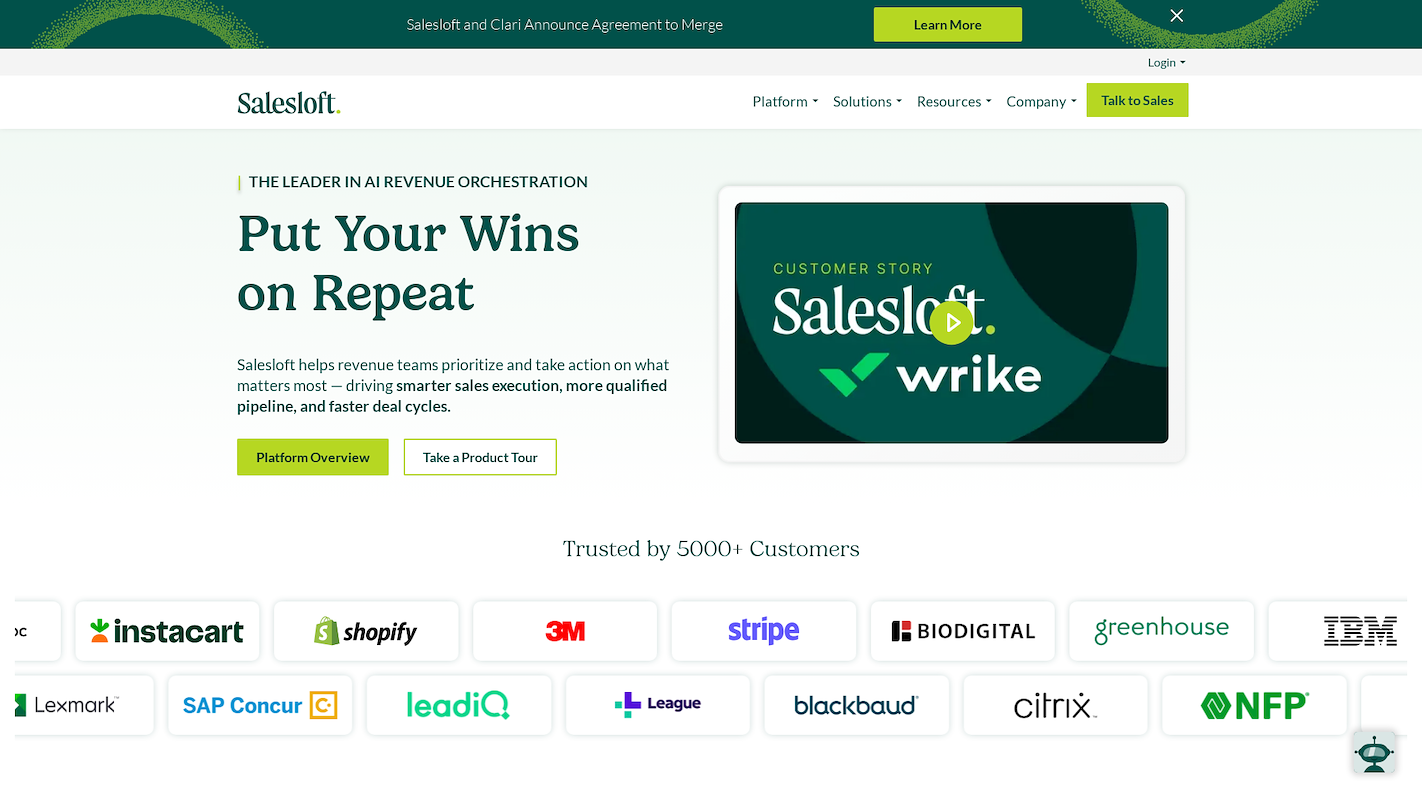
Salesloft is a Revenue Orchestration Platform. It combines sales engagement, AI insights, conversation intelligence, and deal management into one workflow, along with tools for sales forecasts.
Its AI agents find buyer signals and automate tasks, which helps teams build pipeline and shorten deal cycles. The platform's deal and forecast modules serve to accelerate and manage opportunities.
Salesloft's Main Features
- Uses an AI prioritization engine, Rhythm, to recommend the right actions at the right moments.
- Engages website visitors with real-time, personalized conversations using Drift AI chat agents.
- Manages deals and pipeline with AI insights into risk, next steps, and velocity.
- Combines real-time deal data, AI, and seller input for more accurate forecasting.
How Salesloft Compares to Amplemarket
Average Review score: 4.5/5 stars based on 4,145 G2 reviews
- Salesloft uses an AI engine, Rhythm, to recommend the next best action for reps. This provides more dynamic guidance compared to the structured outreach sequences in Amplemarket.
- It offers conversation intelligence to analyze calls and meetings for key topics. This feature gives deeper interaction insights than Amplemarket's standard engagement metrics.
- The platform includes deal management and forecasting tools to manage the sales pipeline. This is a different focus from Amplemarket, which centers on lead generation and outreach.
- Its Drift AI chat agents engage website visitors in real time. This adds an inbound channel that is not a core part of Amplemarket's outbound-focused system.
Where Salesloft Differs From Amplemarket
- Salesloft lacks a native lead database. Teams may need a separate tool to find new leads, unlike Amplemarket, which includes lead generation and data enrichment in its platform.
- The tool's automation might feel less robust for very large or complex campaigns. Amplemarket, in comparison, designs its platform around a powerful sequencing engine built for high-volume outreach.
- Some users note occasional issues with call quality or email syncs, which can interrupt workflows. Amplemarket's specialized focus on outreach means its core communication features are often very reliable.
Pricing, Plans, and Value
Both platforms require custom quotes and have a high perceived cost. User data suggests Amplemarket may offer a faster return on investment (8 months vs. 11) and slightly higher average discounts. For exact pricing, contact their sales teams or visit Salesloft's official website.
3) Apollo.io

Apollo.io is a sales intelligence platform with engagement tools. It provides access to a large B2B contact database to find prospects. The system integrates data, lead scores, and outreach functions into a single workspace for sales teams.
Common uses involve the discovery of new leads and the execution of email campaigns. The platform also supports call management and task automation to connect with potential customers and track sales activities.
Apollo.io's Main Features
- Provides access to a large B2B contact database to find prospects.
- Uses a lead scoring system to help prioritize potential customers.
- Integrates data, lead scores, and outreach functions into a single workspace.
- Supports call management and task automation to track sales activities.
How Apollo.io Compares to Amplemarket
Average Review score: 4.7/5 stars based on 8,904 G2 reviews
- Apollo.io provides a native B2B database with over 210 million contacts. This offers a more extensive, integrated source to find prospects compared to Amplemarket's lead generation tools.
- The platform offers a free plan for individual users. This provides an accessible entry point, while Amplemarket typically requires a custom quote and a larger initial commitment.
- It includes buyer intent data to identify prospects who actively seek solutions. This is a more advanced feature for lead qualification than the standard engagement metrics in Amplemarket.
- Many users find Apollo.io easier to use for lead generation. In contrast, some Amplemarket users report a steeper learning curve to master its full feature set.
Where Apollo.io Differs From Amplemarket
- Some users find its outreach automation less specialized for highly complex sequences. Amplemarket, in comparison, centers its platform on a robust engine designed specifically for large-scale, multi-step campaigns.
- While its B2B database is extensive, some users report issues with data accuracy. Amplemarket's data enrichment is tightly integrated with its outreach tools, which can improve contact quality for active campaigns.
- The platform's broad feature set can sometimes feel less cohesive for a pure sales engagement workflow. In contrast, Amplemarket provides a more unified experience for users who focus only on outreach tasks.
Pricing, Plans, and Value
Apollo.io has a transparent pricing model with a free plan and paid tiers starting at $49 per user, making it a flexible option for smaller teams. Amplemarket uses a custom quote model, which typically aligns with larger organizations that require enterprise-level features and support. For the most current pricing, visit Apollo.io's official website.
4) Klenty

Klenty is a sales engagement platform that helps sales teams with outreach. Reps can automate follow-ups and personalize communication across email, calls, and LinkedIn. The tool is built to manage multi-channel contact with prospects.
Sales teams use the platform to run sales cadences and book meetings. It also serves to manage prospect interactions within a single system. The goal is to connect with potential customers through structured communication.
Klenty's Main Features
- Dials up to five numbers at once with a parallel dialer, making up to 350 calls per hour.
- Deploys an AI chat agent on websites to qualify leads using BANT/MEDDIC frameworks and book meetings.
- Uses an autonomous AI SDR to research accounts, create personalized outreach, and book meetings.
- Enforces cold-calling methodology and provides real-time coaching with AI talk-track tables.
How Klenty Compares To Amplemarket
Average Review score: 4.6/5 stars based on 387 G2 reviews
- Klenty includes a parallel dialer that calls up to five numbers at once. This feature allows for a higher volume of calls compared to the standard calling functions in Amplemarket.
- The platform provides an autonomous AI SDR to handle research and initial outreach. This automates top-of-funnel tasks differently than Amplemarket's user-managed campaign system.
- It deploys an AI chat agent on websites to qualify inbound leads. This adds a real-time lead capture channel that is not a core part of Amplemarket's outbound system.
- This tool offers AI talk-track tables for real-time coaching during cold calls. This provides more structured guidance for reps during live conversations than Amplemarket's general engagement tools.
Where Klenty Differs From Amplemarket
- Klenty lacks a native lead database, so teams often need a separate tool to find new contacts. Amplemarket, in contrast, includes lead generation and data enrichment as part of its core platform.
- Some users report that its campaign management features can feel less robust for very complex or large-scale sequences. Amplemarket designs its platform around a sequencing engine built for high-volume outreach.
- The tool's reporting capabilities might seem limited for teams that need deep analytics. In comparison, Amplemarket provides analytics that connect the entire process from lead discovery to engagement.
Pricing, Plans, and Value
Klenty offers transparent pricing with plans that range from $50 to $100 per user per month. Amplemarket, in contrast, uses a custom quote model, which generally suits larger organizations that require a tailored package.
5) Groove
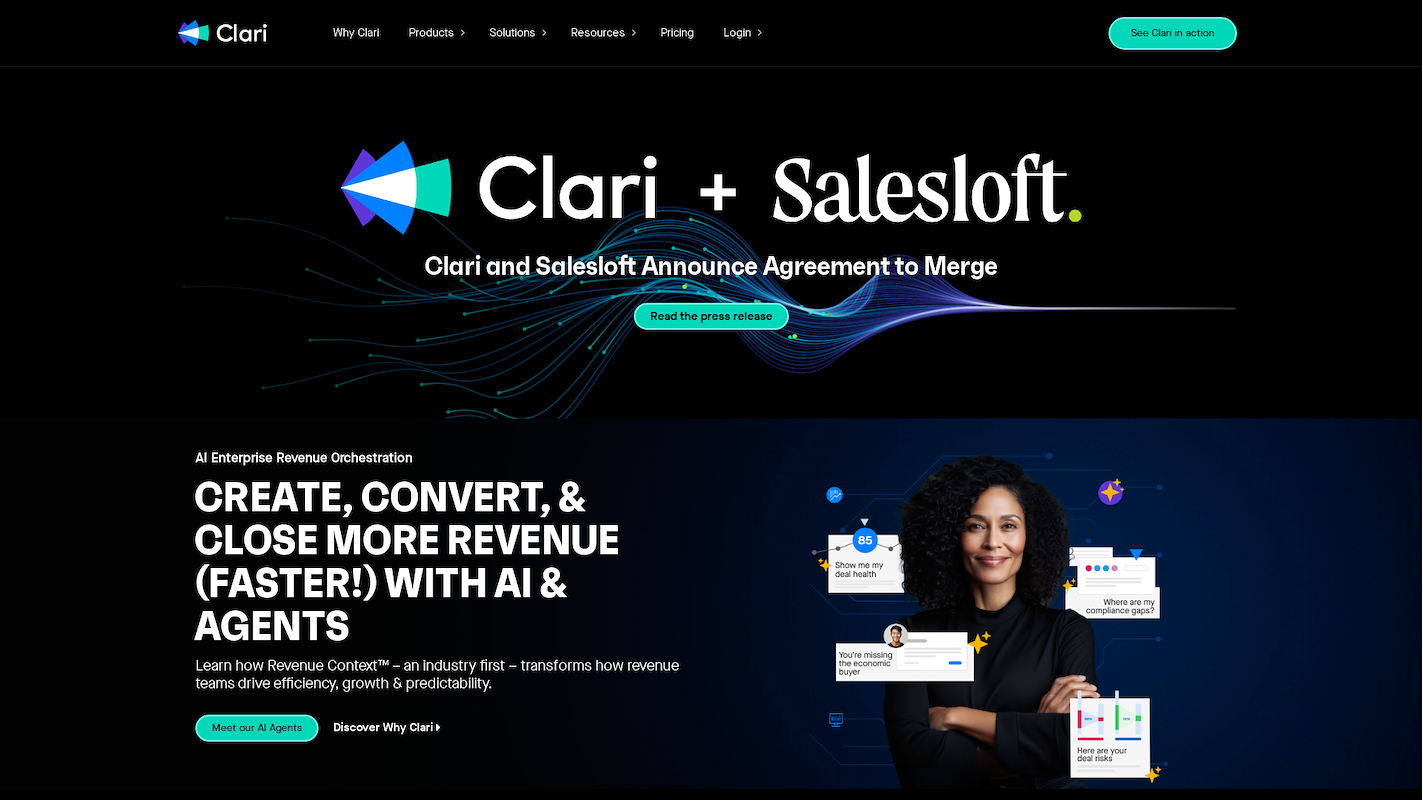
Groove, now part of Clari, is a sales engagement platform built for Salesforce users. It automates tasks and logs all sales activities directly into the CRM. Teams use it to manage multi-channel campaigns across email, calls, and LinkedIn.
The system helps reps build pipeline and manage prospect interactions without manual data entry. This focus on Salesforce integration supports clean data and consistent workflows for revenue teams.
Groove's Main Features
- Logs all sales activities from email, calls, and LinkedIn directly into Salesforce.
- Automates CRM data entry to support clean and consistent workflows for revenue teams.
- Manages multi-channel campaigns and provides a space to handle prospect interactions.
How Groove Compares To Amplemarket
Average Review score: 4.6/5 stars based on 193 G2 reviews
- Groove provides a ticket and case management system for customer support. This is a different function compared to Amplemarket's focus on managing sales prospects.
- It includes a shared inbox that allows teams to handle customer inquiries collaboratively. Amplemarket's communication tools are designed for individual sales outreach, not team-based support.
- The platform offers a knowledge base for customer self-service. This contrasts with Amplemarket, which provides tools for sales reps to engage prospects directly.
- Its system can convert incoming emails into support cases automatically. Amplemarket uses email to run outbound sales sequences rather than manage inbound support requests.
Where Groove Differs From Amplemarket
- Groove does not include a native lead database. This requires sales teams to use a separate tool for prospecting, unlike Amplemarket, which integrates lead generation and data enrichment.
- The platform centers on customer support workflows like ticketing. It lacks the specialized sales sequencing engine that Amplemarket provides for large-scale, multi-step outreach campaigns.
- Some users report its reporting features are limited for sales purposes. This is different from Amplemarket, which offers analytics to track the entire process from lead discovery to engagement.
Pricing, Plans, and Budget Impact
Groove offers transparent pricing plans from $15 to $40 per user per month, making it a predictable option for smaller teams. Amplemarket uses a custom quote model, which typically aligns with larger organizations requiring an enterprise-level solution.
A Final Note on 11x
If the concept of digital workers aligns with your strategy, 11x is a platform to consider. It provides autonomous agents that handle sales development, from prospecting to outreach, to support your existing team.
This model can be a practical way to scale sales operations. To see if AI agents fit your workflow, you can explore how 11x might address your specific business requirements.
With 11x, AI runs the sales playbook. Alice finds accounts, enriches their data, and drives outreach, while Julian qualifies prospects and schedules meetings. The platform combines intent signals and email warmup, which replaces the need for separate tools in a GTM stack.
Book a demo to see the platform in action.
6) Reply.io
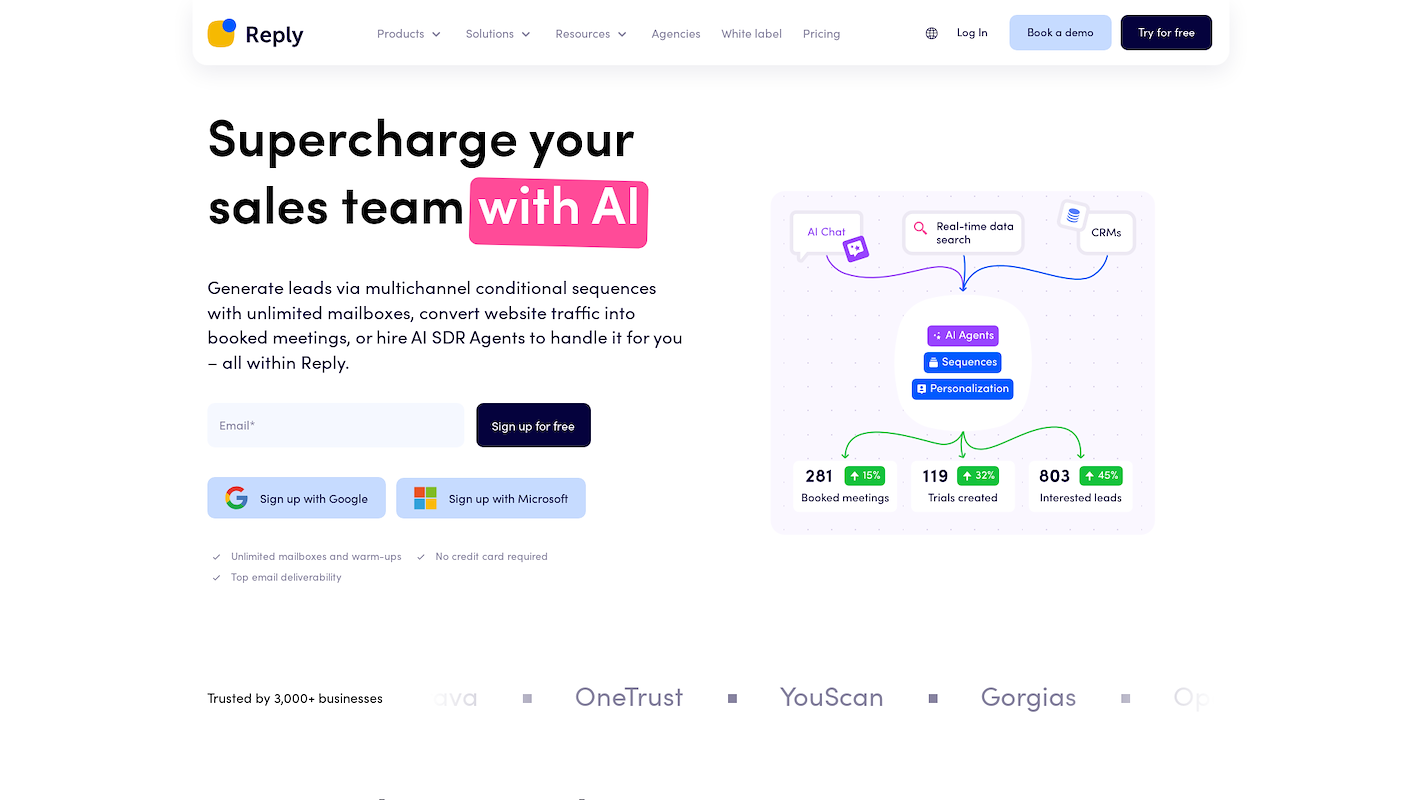
Reply.io is a sales engagement platform for multi-channel outreach. It uses AI to automate communication and helps teams find contacts with its B2B database. The system supports email, calls, and social media touchpoints.
Sales teams use it to execute outreach sequences, book meetings, and manage prospect data. The platform centralizes sales activities to connect with potential customers.
Reply.io's Main Features
- Offers an optional managed AI SDR agent, Jason, to automate prospecting, personalization, and meeting booking.
- Includes a deliverability suite with over 30 tools, such as an email health checker, unlimited warm-ups, and inbox rotation.
- Supports multichannel conditional sequences that use email, LinkedIn, WhatsApp, SMS, and Zapier-connected channels.
- Provides access to a B2B contact database with over one billion records and includes intent signals for lead discovery.
How Reply.io Compares To Amplemarket
Average Review score: 4.6/5 stars based on 1,458 G2 reviews
- Reply.io includes a full deliverability suite with email health checks and unlimited warm-ups. This offers more tools to maintain sender reputation compared to Amplemarket's standard warmup features.
- The platform offers an optional AI SDR agent to automate prospecting and book meetings. This provides a hands-off approach to outreach, unlike Amplemarket's system, which requires users to manage campaigns directly.
- It supports more outreach channels like WhatsApp and SMS within its sequences. This gives users more ways to contact prospects than Amplemarket's primary focus on email and LinkedIn.
- This tool has an AI chat for websites to engage visitors and book meetings. This adds an inbound lead capture method that is not a core part of Amplemarket's outbound platform.
Where Reply.io Differs From Amplemarket
- Some users report its automation feels less robust for highly complex sequences. Amplemarket, in contrast, builds its platform around a sequencing engine designed specifically for large-scale, multi-step campaigns.
- While it includes a large B2B database, some reviews mention issues with data accuracy. Amplemarket’s data enrichment is tightly integrated into its outreach tools, which can improve contact quality for campaigns.
- The platform's broad feature set can sometimes feel less unified for a pure sales engagement workflow. Amplemarket provides a more focused experience for users who concentrate only on outreach and lead generation tasks.
Pricing, Plans, and Value
Reply.io offers transparent pricing with a free plan and paid tiers starting at $49 per user per month, making it a flexible option for smaller teams. Amplemarket uses a custom quote model, which generally suits larger organizations that require a tailored package.
7) Mixmax

Mixmax is a sales engagement platform that works inside Gmail. It adds tools for email analytics, one-click meeting schedules, and automated outreach sequences to a user's inbox. This helps sales teams manage their workflow from one place.
Teams use the system to handle communication with prospects and customers. The platform's main use is to execute sales tasks directly from an email client, which supports a more focused work process.
Mixmax's Main Features
- Auto-generates meeting notes, summaries, and follow-up email drafts with its Meeting Copilot.
- Delivers emails at optimal times for engagement using an AI Smart Send feature.
- Provides an AI Engagement Score to help prioritize prospects based on interaction data.
- Includes an Inbox Sidechat for internal team collaboration directly within the email client.
How Mixmax Compares To Amplemarket
Average Review score: 4.6/5 stars based on 1,433 G2 reviews
- Mixmax operates directly within the Gmail inbox. This provides a more integrated workflow for users compared to Amplemarket, which functions as a separate application.
- It allows users to embed interactive elements like polls and surveys into emails. This offers a different way to engage prospects than the standard outreach sequences in Amplemarket.
- The platform includes a Meeting Copilot that automates notes and summaries. This supports post-meeting activities, a different focus from Amplemarket's tools which center on outreach.
- This tool offers an Inbox Sidechat for team collaboration inside the email client. This contrasts with Amplemarket, where communication tools are for individual sales outreach.
Where Mixmax Differs From Amplemarket
- Mixmax does not include a native lead database for prospecting. Teams often need a separate tool to find new contacts, while Amplemarket integrates lead generation and data enrichment into its platform.
- The tool operates exclusively within Gmail, which may not suit teams that use other email clients. In contrast, Amplemarket is a standalone application that provides a dedicated environment for sales tasks.
- Its outreach automation is built for workflows inside the inbox. Some users may find it less suited for complex, high-volume campaigns compared to Amplemarket, which designs its platform around a specialized sequencing engine.
Pricing, Plans, and Value
Mixmax provides transparent pricing with plans starting at $49 per user per month, making it a predictable option for teams. Amplemarket uses a custom quote model, which generally aligns with larger organizations that need a solution tailored to enterprise requirements.
8) Mailshake

Mailshake is a sales engagement tool for cold outreach. It helps sales teams automate email campaigns and follow-ups. The platform supports communication across email, phone, and social media to connect with prospects.
Teams use the system to manage sales sequences and track engagement. The main purpose is to start conversations with potential customers through personalized, automated contact.
Mailshake's Main Features
- Manages outreach tasks across email, phone, and social media within a single sequence.
- Uses AI to schedule emails for the best time of day to improve engagement.
- Integrates natively with CRMs like Salesforce, Pipedrive, and Hubspot.
How Mailshake Compares To Amplemarket
Average Review score: 4.7/5 stars based on 326 G2 reviews
- Mailshake offers transparent pricing plans, which provides cost predictability for smaller teams. This is different from Amplemarket, which uses a custom quote model suited for enterprise needs.
- The platform is often noted for its simplicity and easy setup for cold email campaigns. In comparison, some users find Amplemarket has a steeper learning curve due to its extensive feature set.
- It uses an AI feature to schedule email delivery at the best time for engagement. This provides a specific type of optimization compared to Amplemarket's broader campaign automation tools.
- This tool provides a focused dashboard for managing email, phone, and social media tasks in one sequence. This approach can appeal to teams that want a straightforward tool for core outreach, compared to Amplemarket's more comprehensive system.
Where Mailshake Differs From Amplemarket
- Mailshake does not include a native lead database, so teams often need a separate tool for prospecting. Amplemarket, in contrast, integrates lead generation and data enrichment, providing a more self-contained system.
- Its automation is designed for direct cold outreach campaigns. For very complex, large-scale sequences, some users might find it less robust than Amplemarket's specialized sequencing engine.
- The platform's analytics focus on core outreach metrics like opens and clicks. This is different from Amplemarket, which provides reporting that covers the entire sales cycle from lead generation to engagement.
Pricing, Plans, and Value
Mailshake provides transparent pricing, with plans ranging from $29 to $99 per user per month, making it a predictable choice for smaller teams. In contrast, Amplemarket uses a custom quote model, which generally suits larger organizations with enterprise-level requirements and budgets.
9) Lemlist
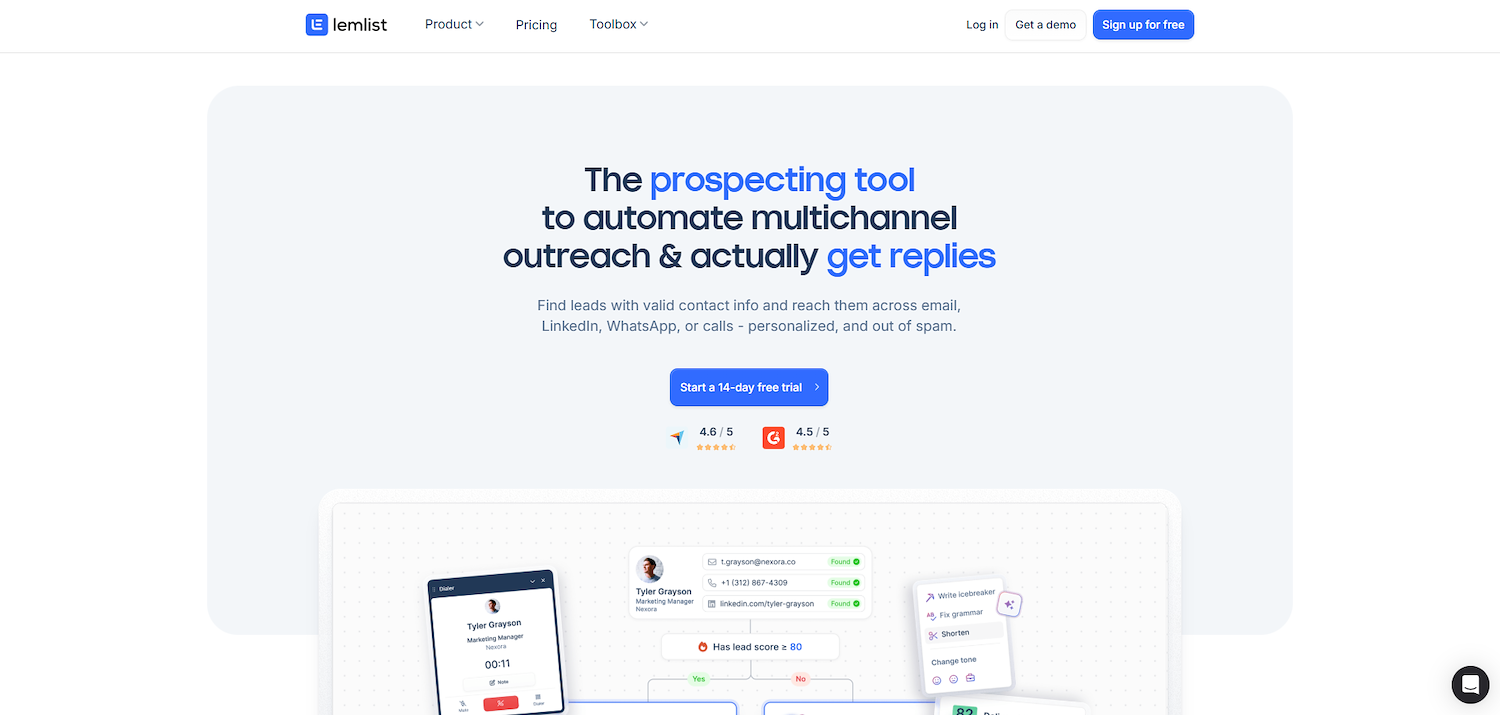
Lemlist is a sales engagement platform for personalized outreach across multiple channels. It allows teams to automate campaigns with custom images and videos in emails to boost replies.
Common uses include email domain warm-ups and sales sequence management. The main goal is to start conversations and book meetings with prospects through tailored contact.
Lemlist's Main Features
- Inserts dynamic text, images, and videos into messages to personalize outreach.
- Integrates with LinkedIn via a Chrome extension to manage profile visits, connection requests, and direct messages.
- Incorporates phone calls directly into outreach sequences with options to log call outcomes.
- Includes email deliverability tools to monitor and optimize sending practices.
How Lemlist Compares To Amplemarket
Average Review score: 4.4/5 stars based on 276 G2 reviews
- Lemlist allows users to add dynamic images and videos to emails. This offers a different level of personalization for outreach campaigns compared to the text-based sequences in Amplemarket.
- The platform includes a suite of email deliverability tools. This provides more control over sender reputation than the standard email warm-up features found in Amplemarket.
- It integrates phone calls directly into outreach sequences. This allows reps to manage calls as a step in their cadence, a different approach from Amplemarket's primary focus on email and social media automation.
- This tool uses a Chrome extension for LinkedIn tasks like profile visits and connection requests. This provides a manual, browser-based workflow, which contrasts with Amplemarket's more automated system for large-scale engagement.
Where Lemlist Differs From Amplemarket
- Lemlist lacks a native lead database, so teams often need a separate tool for prospecting. Amplemarket, in contrast, integrates lead generation and data enrichment into its platform.
- Its automation is designed for direct outreach. For very complex, large-scale sequences, some users might find it less robust than Amplemarket's specialized sequencing engine.
- The platform's analytics focus on core outreach metrics. This is different from Amplemarket, which provides reporting that covers the entire process from lead discovery to engagement.
Pricing, Plans, and Value
Lemlist offers transparent pricing with a free plan, an Email Pro plan at $55 per year, and a Multichannel Expert plan at $79 per month. This model provides a predictable option for smaller teams, while Amplemarket uses a custom quote system better suited for larger organizations with enterprise needs.
10) Snov.io
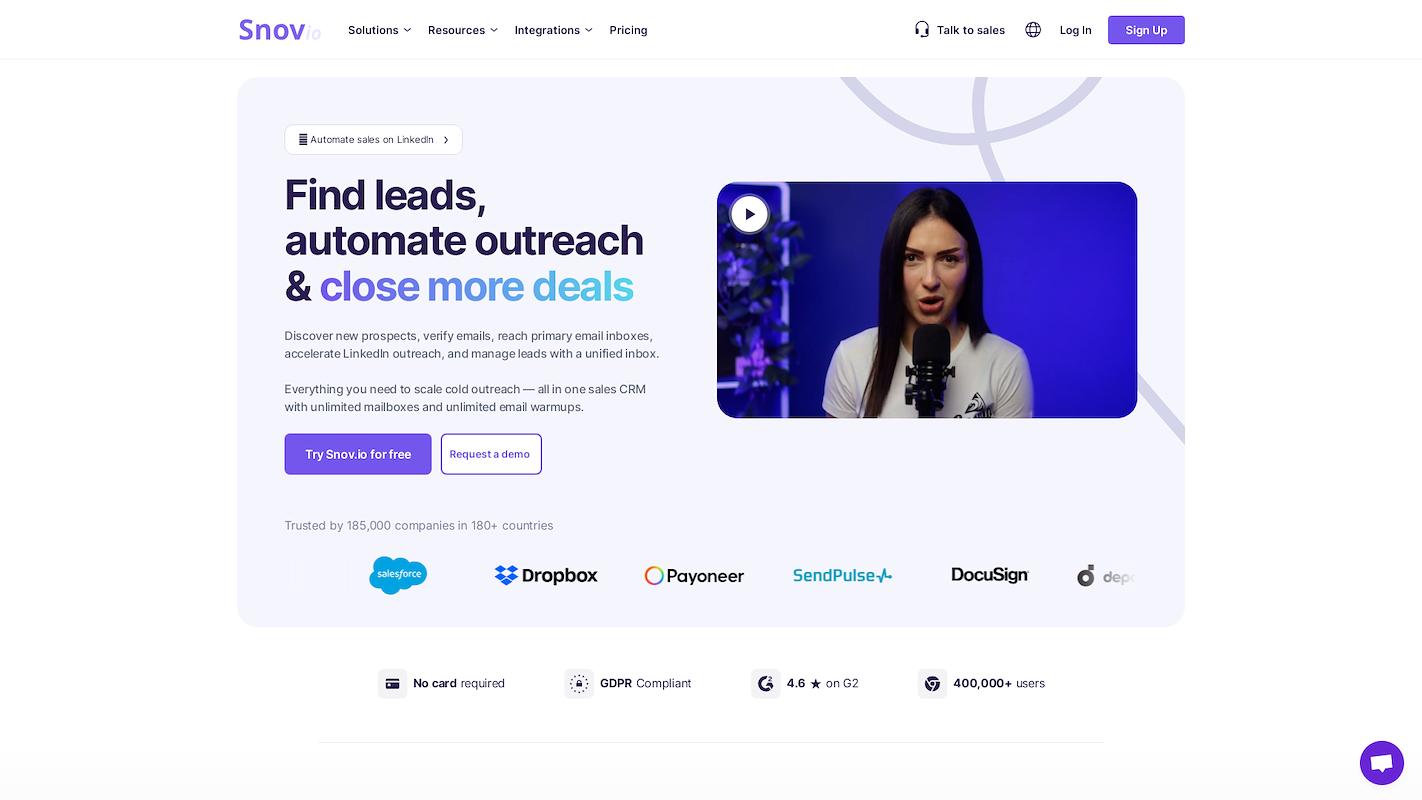
Snov.io is a sales automation platform for outreach and lead generation. It combines an email finder, a verifier, and tools for drip campaigns into one system. Sales teams use it to find contacts and build prospect lists.
The platform also lets users execute automated email sequences and track engagement. This helps manage the sales process from a central location.
Snov.io's Main Features
- Manages contacts and accounts within the platform.
- Handles opportunity and pipeline management for sales teams.
- Offers reporting and analytics through visual dashboards.
- Provides access to contact, company, and industry research data.
How Snov.io Compares To Amplemarket
Average Review score: 4.6/5 stars based on 450 G2 reviews
- Snov.io includes opportunity and pipeline management tools, which let teams track deals inside the platform. This is different from Amplemarket, which concentrates on the top-of-funnel outreach stages.
- It provides built-in contact and account management that can work as a basic CRM. This contrasts with Amplemarket, which is built to integrate with external CRM systems for full contact management.
- The platform offers transparent pricing plans, including a free trial and paid tiers. This gives teams a predictable cost, unlike Amplemarket's custom quote model designed for enterprise needs.
- This tool has visual dashboards for reporting on sales activities. This provides a different way to view analytics compared to Amplemarket's reports, which connect lead discovery with engagement data.
Where Snov.io Differs From Amplemarket
- Snov.io's automation focuses on email drip campaigns. For teams that run highly complex or large-scale sequences, Amplemarket's specialized engine may offer more robust options.
- The platform's email finder is a core feature. However, some users note occasional data accuracy issues. Amplemarket, in contrast, tightly integrates data enrichment with its outreach tools, which can improve contact quality for active campaigns.
- Its reporting provides visual dashboards for sales activities. This is different from Amplemarket, which offers analytics that connect the entire process from lead discovery to engagement, providing a more complete view of the sales funnel.
Pricing, Plans, and Value
Snov.io provides transparent pricing with plans like its Starter tier at $39 per month, offering a predictable cost for teams. Amplemarket uses a custom quote model, which typically aligns with larger organizations that require a tailored, enterprise-level package.
Which One Should You Go With?
Choosing an Amplemarket alternative involves many variables. This guide reviewed several options to help you find the right fit for your team's specific requirements and goals.
If your team is considering digital workers, 11x offers a different approach. Its AI agents can manage sales development tasks, which may be a practical way to scale your operations without increasing headcount.




